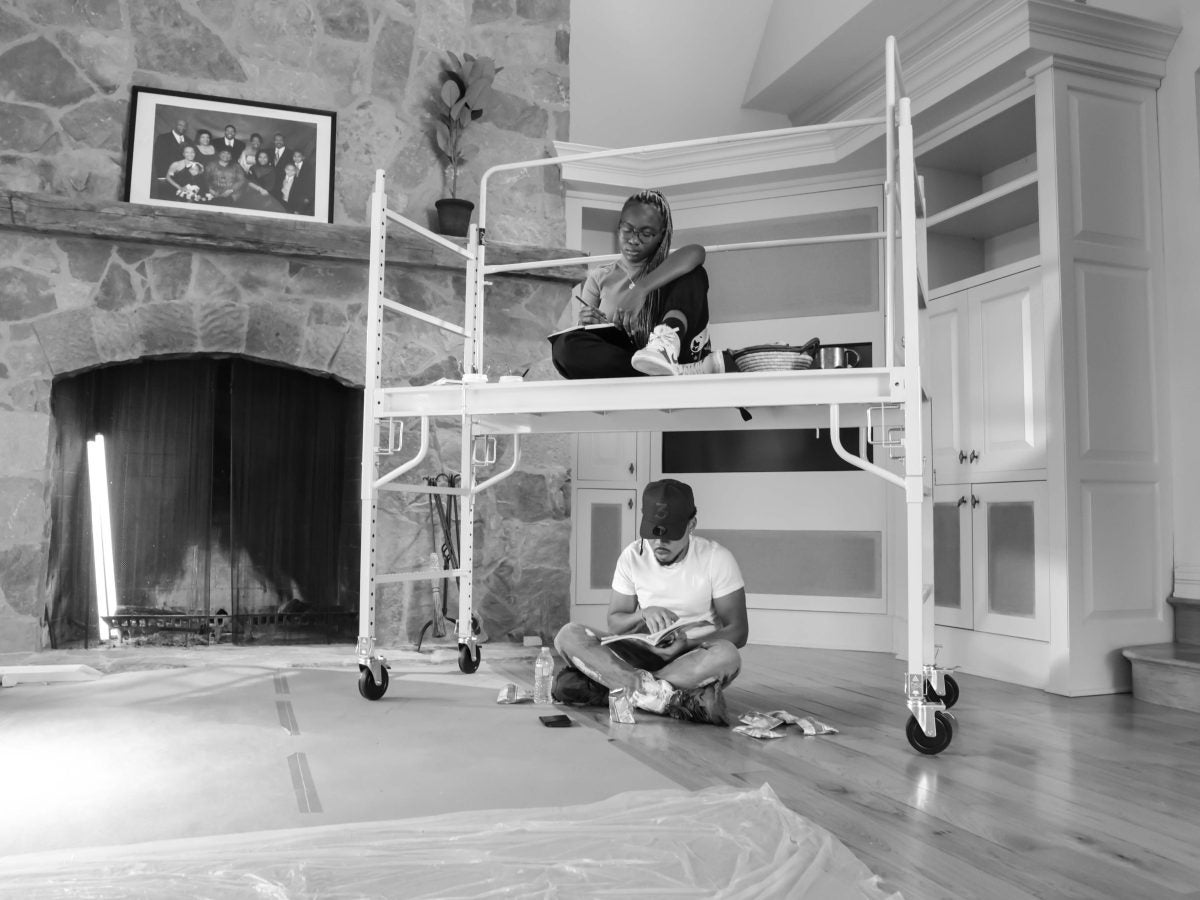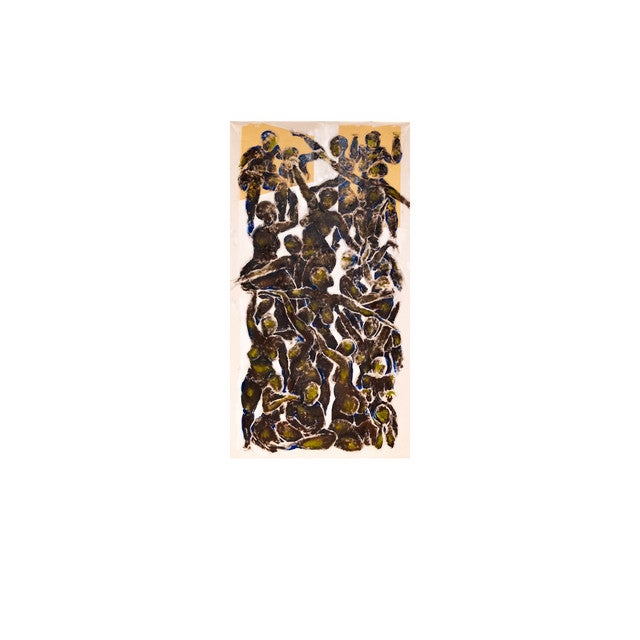
When Chancelor “Chance the Rapper” Bennett and Naïla Opiangah met at a studio space in Ghana last year; what started out as a conversation between two like-minded creatives, set in place a series of events that can be described as nothing less than divine.
On March 24, 2022, the single “Child of God,” was released in conjunction with an art installation of the same name at the Museum of Contemporary Art Chicago. Both pieces – the song and the artwork – were truly collaborative efforts, and explored themes of religion, resilience, and staying true to your process, whatever that may be.
Chance and Naïla spoke with ESSENCE about the experience of creating together, and just how essential “Child of God” would prove to become in their respective industries and beyond.
“I think the importance of the track and what’s being said by “Child of God” is that sometimes we forget who we are, and the track is a reminder of our purpose, and the talents that each one of us possess,” Chance said. “Many times, we look ahead to our next task – however stressful it may be – and we think that we can’t overcome it. In the process of trying to complete something, there’s always something in your mind saying that you can do it, you just have to push through and have faith in the man above.”
“I feel that being a child of God is innate, or inherent, and can apply to every single person, regardless of your profession, who you think you are, how much money you have, or whatever is plaguing you as a roadblock,” he continued. “Once that’s finally realized, you’ll understand that there is nothing on the earth that you should be afraid of.”
The song “Child of God,” is very much about process. The process of creating, and definitely the process of fulfilling one’s purpose. After the release of the critically mixtape Acid Rap in 2013, Chance spent about a month in Atlanta, and wrote a lot of songs that ended up on Coloring Book a few years later. During his time there, he got together with some of the seminal artists of this generation. Their process of recording – “punchcutting” as it is called – influenced the Chicago-born rapper to alter the way he constructed music for years to come.
“When I got to Atlanta, I started rocking with people like Young Thug and Quavo, and most people think of them as rappers, but they’re also engineers because they’re really knowledgeable about Pro Tools,” the Grammy award-winning artist stated. “They track themselves and they do this process called “punchcutting,” which a lot of people in the industry do; but basically, instead of writing a whole verse and reciting it on the mic, you write it line by line, then record it as it comes to you. It’s almost akin to freestyling, and it takes away the pressure of getting it all done in one take.”
Prior to this shift in the way he created music, Chance would normally write using the tried-and-true method of adding pen to paper. In fact, before his career as a rapper, we would regularly write poetry. A female poet sat in on one of his recording sessions and got the opportunity to observe the musician in his element. Her input regarding his process put things in perspective and inspired him to become more deliberate in his creativity.
“I had an amazing conversation with this poet while I was in the studio,” said the father of two. “She told me that I wasn’t respecting my process, and that I really didn’t have a process for how to go about creating works. She then said that when I figured out what my process is, I had to discipline myself to respect it. Once that happened, then I could get other people to respect my process, thus allowing me to ultimately love my process. All those things eventually came into fruition over time.”
“I got back to my paper and pen because that’s how I grew up,” he added. “Before I had anything, before I had beats, I used to just, write. I figured that if I was going to make a very intentional and well-written project then I might as well actually write it down in this composition notebook that I have. Most importantly, I started focusing on my process again.”
As Chance penned the lyrics to “Child of God” – which was the third piece he wrote after adopting his old process – he would listen to “Process” by Samora Pinderhughes. The song resonated with the rapper, because the lyrics spoke about vulnerability, and the responsibility of being an artist. It would be his meeting with visual artist Naïla Opiangah in January of this year that would further challenge that responsibility.
Opiangah was born and raised in Gabon – which is a French speaking country in Central Africa – and moved to Chicago when she was 18 to study architecture. She had been painting for a long time, but really committed to her practice upon graduation. It had been about two years since her rededication to art when she met Chance at Amoako Boafo’s studio in Ghana.
“I was in Ghana because I was going there a lot due to work, and I have a big artist community there that I collaborate with,” Opiangah said. “I have what can be called an “informal” residency at Amoako Boafo’s studio space, with about 6 or 7 other artists who paint and learn from Amoako – he’s really big on building community – and we gain a lot from that. He always has a lot of people come into the studio for us to have a platform, or some sort of exposure.”
“So, when chance arrived at the studio space, I was the one that showed him around – as I do with most people who visit,” the artist continued. “We got to my little spot, and he saw one of my pieces and wanted to buy it, which caused me to ask him if he was a collector because I wanted to ensure that my work was not going to be purchased as a one-time thing. I wanted to make sure that the purchase would be part of a larger piece of documentation – which is what collectors do.”
Throughout the course of a few days, Chance and Naïla’s conversation evolved into a talk about their individual observations of the music and art world, along with some of the frustrations that come with them. So, as they began to understand each other, the two creatives also built a profound connection on an emotional level that would soon manifest itself into “Child of God,” a 12×6 ft. painting hand crafted by the Gabonese artist herself, with some inspiration from the 28-year-old emcee.

Opiangah, a graduate of the Illinois Institute of Technology, finished “Child of God” under an immense amount of pressure. She was asked to perform on camera, in front of a huge film crew, in a city that she hadn’t been to in quite some time – and she rose to the occasion. In only three days, she created a work of art that will be prized and studied for years to come.
After the painting was completed, the two understood that there was still a massive amount of work to do. They believed that it was definitely a higher power at play. Something – or someone – outside of themselves made everything come together as seamlessly as it did, and they were also blessed that their mind’s aligned for this very special collaboration.
“What more so happened than just us aligning, I feel like we aligned with God’s will,” Chance said. “This is something that was going to be made regardless; that’s how divine all of this was. Beyond that, I had no idea what the song was when I first started making it. From recording Moses Sumney’s vocals, to meeting Amoako Boafo and his artists and so on, the success of this song can only be attributed to God’s will. I feel like we’re purposeful, and we can’t lose because we’re doing something that’s bigger than us.”
Opiangah reiterated the sentiment, and also touched upon the unlikelihood of their chance meeting – no pun intended – although living in different parts of the world, they still arrived at the same place in life, at the same time.
“I am a person of faith, and when something can’t be explained scientifically – I think it’s’ God,” Naïla spoke on how “Child of God” came to be. “The way everything came to be, it was almost miraculous. Because again, it’s uncommon to not just be on the same wavelength as someone, on the journey to understanding oneself; but meeting someone at the same point. It’s not about meeting someone who’s cool, who’s talented, etc., it’s about meeting someone that’s receptive to the same spiritual or emotional language.”
“You have to be in tune with someone in order to create something that beautiful,” she added. “So, I’m very grateful that I made the deep commitment to bettering myself, to understanding myself, to being more honest with myself. And I’m really happy that he did the same. Because had we not gone through these tough journeys, we would not have spoken the same language when we met.”





